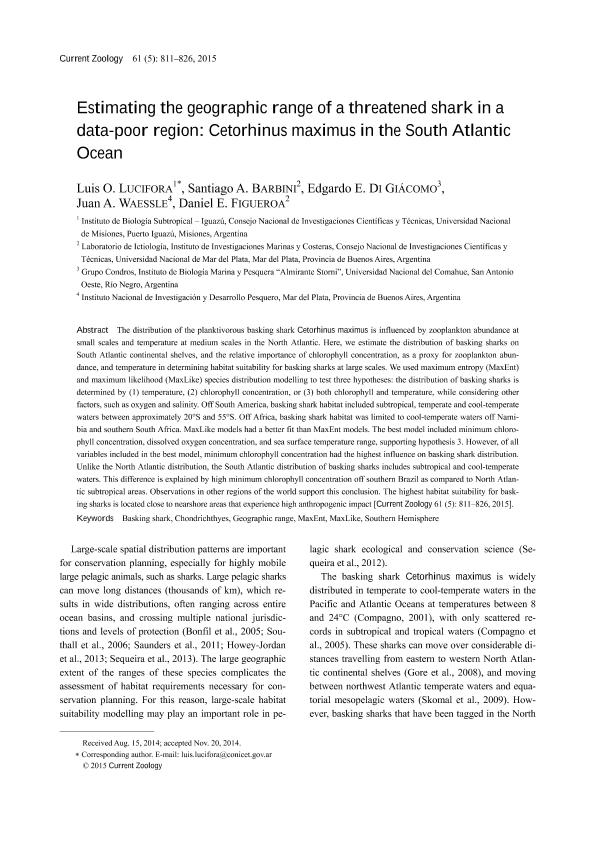Mostrar el registro sencillo del ítem
dc.contributor.author
Lucifora, Luis Omar

dc.contributor.author
Barbini, Santiago Aldo

dc.contributor.author
Di Giacomo, Edgardo Ernesto

dc.contributor.author
Waessle, Juan A.
dc.contributor.author
Figueroa, Daniel Enrique

dc.date.available
2018-05-10T13:31:22Z
dc.date.issued
2015-10
dc.identifier.citation
Lucifora, Luis Omar; Barbini, Santiago Aldo; Di Giacomo, Edgardo Ernesto; Waessle, Juan A.; Figueroa, Daniel Enrique; Estimating the geographic range of a threatened shark in a data-poor region: Cetorhinus maximus in the South Atlantic Ocean; Oxford University Press; Current Zoology; 61; 5; 10-2015; 811-826
dc.identifier.issn
1674-5507
dc.identifier.uri
http://hdl.handle.net/11336/44724
dc.description.abstract
The distribution of the planktivorous basking shark Cetorhinus maximus is influenced by zooplankton abundance at small scales and temperature at medium scales in the North Atlantic. Here, we estimate the distribution of basking sharks on South Atlantic continental shelves, and the relative importance of chlorophyll concentration, as a proxy for zooplankton abundance, and temperature in determining habitat suitability for basking sharks at large scales. We used maximum entropy (MaxEnt) and maximum likelihood (MaxLike) species distribution modelling to test three hypotheses: the distribution of basking sharks is determined by (1) temperature, (2) chlorophyll concentration, or (3) both chlorophyll and temperature, while considering other factors, such as oxygen and salinity. Off South America, basking shark habitat included subtropical, temperate and cool-temperate waters between approximately 20°S and 55°S. Off Africa, basking shark habitat was limited to cool-temperate waters off Namibia and southern South Africa. MaxLike models had a better fit than MaxEnt models. The best model included minimum chlorophyll concentration, dissolved oxygen concentration, and sea surface temperature range, supporting hypothesis 3. However, of all variables included in the best model, minimum chlorophyll concentration had the highest influence on basking shark distribution. Unlike the North Atlantic distribution, the South Atlantic distribution of basking sharks includes subtropical and cool-temperate waters. This difference is explained by high minimum chlorophyll concentration off southern Brazil as compared to North Atlantic subtropical areas. Observations in other regions of the world support this conclusion. The highest habitat suitability for basking sharks is located close to nearshore areas that experience high anthropogenic impact.
dc.format
application/pdf
dc.language.iso
eng
dc.publisher
Oxford University Press

dc.rights
info:eu-repo/semantics/openAccess
dc.rights.uri
https://creativecommons.org/licenses/by-nc-sa/2.5/ar/
dc.subject
Basking Shark
dc.subject
Chondrichthyes
dc.subject
Geographic Range
dc.subject
Maxent
dc.subject
Maxlike
dc.subject
Southern Hemisphere
dc.subject.classification
Otras Ciencias Biológicas

dc.subject.classification
Ciencias Biológicas

dc.subject.classification
CIENCIAS NATURALES Y EXACTAS

dc.title
Estimating the geographic range of a threatened shark in a data-poor region: Cetorhinus maximus in the South Atlantic Ocean
dc.type
info:eu-repo/semantics/article
dc.type
info:ar-repo/semantics/artículo
dc.type
info:eu-repo/semantics/publishedVersion
dc.date.updated
2018-05-04T20:14:21Z
dc.journal.volume
61
dc.journal.number
5
dc.journal.pagination
811-826
dc.journal.pais
Reino Unido

dc.journal.ciudad
Oxford
dc.description.fil
Fil: Lucifora, Luis Omar. Consejo Nacional de Investigaciones Científicas y Técnicas. Centro Científico Tecnológico Conicet - Nordeste. Instituto de Biología Subtropical. Instituto de Biología Subtropical - Nodo Puerto Iguazú | Universidad Nacional de Misiones. Instituto de Biología Subtropical. Instituto de Biología Subtropical - Nodo Puerto Iguazú; Argentina
dc.description.fil
Fil: Barbini, Santiago Aldo. Consejo Nacional de Investigaciones Científicas y Técnicas. Centro Científico Tecnológico Conicet - Mar del Plata. Instituto de Investigaciones Marinas y Costeras. Universidad Nacional de Mar del Plata. Facultad de Ciencia Exactas y Naturales. Instituto de Investigaciones Marinas y Costeras; Argentina
dc.description.fil
Fil: Di Giacomo, Edgardo Ernesto. Universidad Nacional del Comahue. Instituto de Biología Marina y Pesquera Almirante Storni; Argentina
dc.description.fil
Fil: Waessle, Juan A.. Instituto Nacional de Investigaciones y Desarrollo Pesquero; Argentina
dc.description.fil
Fil: Figueroa, Daniel Enrique. Consejo Nacional de Investigaciones Científicas y Técnicas. Centro Científico Tecnológico Conicet - Mar del Plata. Instituto de Investigaciones Marinas y Costeras. Universidad Nacional de Mar del Plata. Facultad de Ciencia Exactas y Naturales. Instituto de Investigaciones Marinas y Costeras; Argentina
dc.journal.title
Current Zoology
dc.relation.alternativeid
info:eu-repo/semantics/altIdentifier/doi/http://dx.doi.org/10.1093/czoolo/61.5.811
dc.relation.alternativeid
info:eu-repo/semantics/altIdentifier/url/https://academic.oup.com/cz/article/61/5/811/1821080
Archivos asociados
